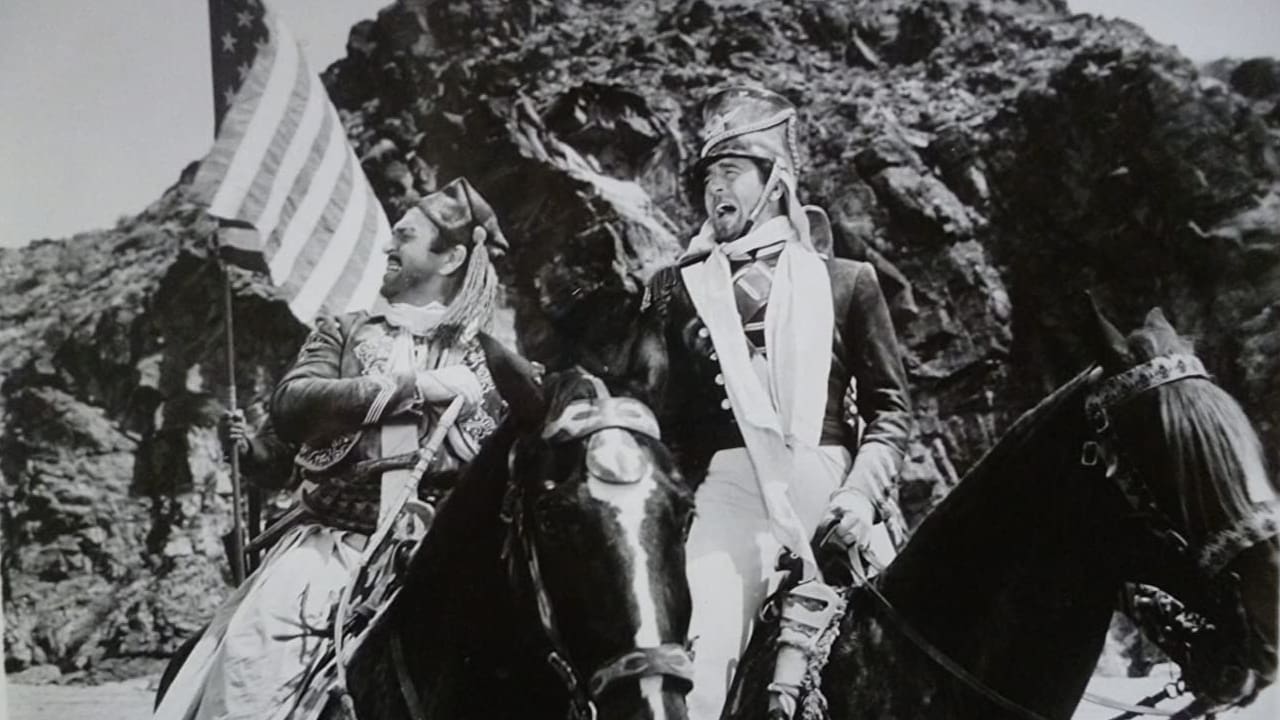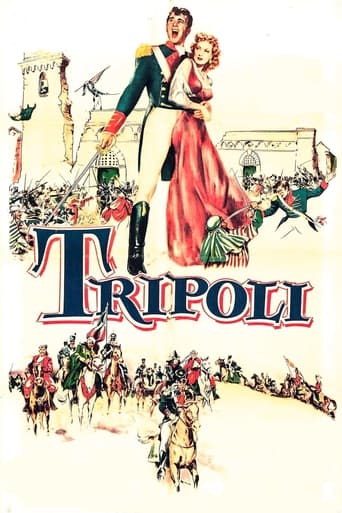

Very well executed
... View MorePurely Joyful Movie!
... View MoreExcellent, Without a doubt!!
... View MoreBest movie ever!
... View MoreIn case you saw To the Shores of Tripoli, a 1942 military romance starring John Payne and Maureen O'Hara, you might assume Tripoli, a 1950 military romance starring John Payne and Maureen O'Hara, would be exactly the same movie. It's not. Neither one of them is very good, but they are quite different.Tripoli takes place in the early 1800s. Pirates in Libya fight against the Marines, and the subsequent march through the desert and battle show audiences why the first line of the USMC theme song starts the way it does. However, the movie is pretty boring, and without the forced romance between John and Maureen, it might have put me to sleep. She starts the movie involved with Phillip Reed, and it's clear she has no real feelings for him but is only after his money and his title. But, since Hollywood was pretty racist back then, it's beyond clear she won't end up with the non-white guy. There's really no suspense, and it's no surprise that she falls for the first white guy she meets.Unless this part of history or battle in particular really interests you, find yourself another war movie. There are thousands to choose from.
... View MoreThis would not have been worth much seeing if it hadn't been for the expedition made from upper Egypt down to Libya with hardships and sandstorms and other frustrating complications along the way by Qattara (Remember "Ice Cold in Alex?" This was 140 years earlier.). This is the realistic part of the film, and it is the more interesting for taking place in 1805 - the war in question is that against Napoleon, which is never mentioned. Maureen O'Hara is a stranded countess courted by a local prince, John Payne runs into her by chance and gets trouble with her from the start, so it seems he just seeks her out to have someone to quarrel with. It's the usual story. Their quarrel and nagging goes on throughout the film until it's time for them to focus their interest on more important matters, like a navy which doesn't want to take orders from John Payne. The military battle in the end is just the usual tearing down the whole city stone by stone after first demolishing the interiors of every palace worth some sight-seeing. Howard de Silva saves the show as an intrepid Greek captain with a company of his own, and hardly anyone of the Americans would have survived without his contribution. It was the first time the American flag was planted outside the States and unfortunately not the last time. A silly story made as spectacular as possible and saved only by history and adventure, but the music throughout is excellent.
... View MoreThis is a classic 1940s/50s lightweight action adventure piece, with all the classic elements: a historical tie-in, small-unit military action, horses, an expedition through a wilderness, a leading man in a classic romanticized leadership mold (here, a U.S. Marine), and of course the love story of two people who get the hots for each other but can't figure out what to do about it except circle and maybe even hiss at each other until a sudden dramatic kiss seals their engagement in the last five seconds of the film. (There was also a certain amount of comic relief, centered in large part around a comic actor or two brought in just for that purpose, as Howard Da Silva, Connie Gilchrist, Grant Withers, and even Lowell Gilmore are here.) It's essentially a formula that was followed countless times during the period, and while the producers could move the setting to anywhere from Louisiana (see, e.g., THE FIGHTING KENTUCKIAN, John Wayne, 1949) to, well, the Shores of Tripoli, for variety, most of them were just westerns, usually set in the Southwestern United States. And for Hollywood in those days, any classic romanticized villain would do, whether it was the Barbary pirates, the staid British Empire in the Battle of New Orleans, or even crooked home-grown American land speculators ready to cheat whoever had money and was handy. This kind of thing was rerun ad infinitum on television when I was growing up and any true TV junkie of the 50's or 60's had seen probably what seemed like at least a couple hundred of these things by the time they finished high school. That's all this movie is or was ever intended to be, and it delivers right down the middle like a strike in bowling alley. As others have observed, the production values and especially the location shooting are excellent for the day, and if you like the late Maureen O'Hara (may she R.I.P.) and John Payne, so much the better. If you are in the mood for such old-fashioned mind candy it is just about perfect, and the only reason I gave it only a six is because by more challenging movie standards it lacks the "edge of the seat" quality needed to bump it up another star. What surprises me is how many of the reviewers on here seem to have no experience with this kind of thing and instead try to analyze it as if it were something made in a much more recent era.I might also add that until the modern (i.e., very modern) era of post-World-War-Two (that means, after 1945, less than 100 years ago) strife broke out in the middle east, there was no particular prejudice against or hatred for Moslems in America or Western Europe generally (at least not for several hundred years, at any rate), who were rather typically regarded as merely different, if not actually exotic or even fascinating. Indeed, as another, especially clever reviewer of this movie on the IMDb suggested, Europeans thought enough of Arabs to adopt their system of numerals (i.e., 1,2,3,4,5, etc., not mention the whole concept of "zero") from them, along with algebra, averages, algorithms (for you computer junkies out there), the name of every star in the sky you could see without a telescope that was worth naming (e.g., Aldebaran, Altair, Deneb, Fomalhaut, etc., etc.) along with any number of words (alcohol, alchemy, admiral, alcove, alfalfa, albatross, azure . . . ) and certainly, LAWRENCE OF ARABIA (1962), an extravaganza about an Englishman who practically tried to turn himself into an Arab during World War One would never have been the immense hit that it was only about 50 years ago. The current trend among a truly ridiculous number of people today towards branding any Moslem as evil is less than 25 years old and is the result of a concerted propaganda campaign straight of of George Orwell's book *1984* -- to get people into line, you first give them a common enemy to hate. (Unfortunately for theses propagandists, too many of us live in a fact-based world, and know that the .001% of the world's 1+ billion Moslems that are terrorists are only a minority of a minority of a minority at best), but then there are always the gullible, the fearful, the paranoid, the hateful, the low, the trashy, and the stupid who will believe anything in order to indulge their appetite for enjoying getting angry.) That kind of mentality had nothing to do with this movie when it came out in 1950.
... View MoreI've seen this film a number of times on TV and caught it in the theaters over a half-century ago and loved it. As a kid, it had great appeal to me and lots of action, fun and, of course, the lovely Maureen O'Hara, who was always worth the price of admission. John Payne was an underused, underrated actor who always turned in solid, albeit low key, performance. This film, which is a yarn based on the military action of the US Marines against the Tripoli pirates basically spins fight scenes between the bad guys and a coalition of good guys, including veteran character actor Howard Da Silva as a Greek mercenary. The good guys win, of course and Payne gets the girl (but we knew that anyway, didn't we?) and this is a film that if it pops up on the late show (no video or DVD listed), is certainly worth checking out for some good, solid escapism.
... View More